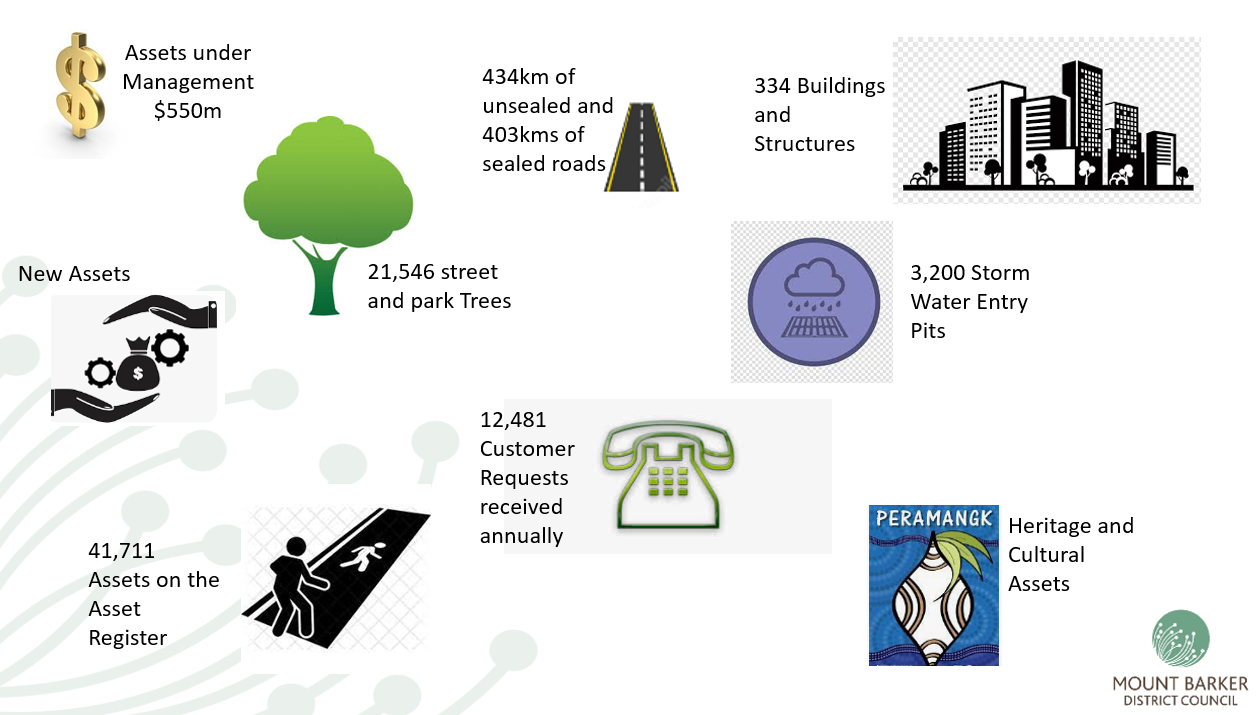Asset Management

At Mount Barker District Council, our vision is to be a community that is smart, culturally rich, prosperous, safe, connected, and sustainable. With an estimated population of over 40,000 residents (in 2024), and with over 500 residential building approvals per year since FY2020/2021, there continues to be continued growth in the region, placing increasing demands on our assets and infrastructure.
Council provides a wide range of services to our community, in urban and rural areas. To deliver these services and enable us to strive towards our vision we own and manage many assets. These assets are categorised into four classes: Transport, Stormwater, Recreation and Open Space, and Buildings. The total replacement value of these assets (excluding plant & equipment, wastewater, land) is approximately $602 million (June 2023).
It is essential that we manage these assets responsibly, to maximise the value and services that they provide.
For this reason, we prepare a ten-year strategic asset management plan following international best-practice through assessing the condition of our assets and determining the investment needed to operate, maintain, renew/replace, upgrade or downgrade as necessary to meet desired service standards and demand. This also meets our obligations under the Local Government Act 1999 Section 122 to prepare an infrastructure and asset management plan.
Strategic Asset Management Plan (SAMP)
The Strategic Asset Management Plan (SAMP) presents the overall investment plan (design, construction, maintenance and operation) for infrastructure over the next ten years.
Assets are critical to supporting our desired lifestyle in a sustainable manner for current and future generations. An example being roads provide a means for transportation and connecting our community to each other as well as services such as health, employment, schools etc.
The SAMP describes Council’s approach to managing the assets under its care and control. It provides a high level / strategic overview of Council’s approach to managing four key classes of assets:
- Transport (sealed and unsealed roads, kerbs, footpaths, bridges, car parks, public lighting)
- Stormwater (stormwater pits, pipes, culverts, gross pollutant traps (GPT), water sensitive urban design (WSUD), wetlands, detention basins
- Recreation and Open Spaces (playgrounds, ovals, playing surfaces, trails)
- Buildings (library, civic spaces, community halls)
The SAMP should be read in conjunction with Council’s key strategic management, planning and policy documents, including the Community Plan, Asset Management Policy, Long Term Financial Plan and Annual
The Draft SAMP 2024-2034 is currently out for community consultation
Business Plan and Budget (found on the Mount Barker District Council website https://www.mountbarker.sa.gov.au)
This SAMP does not include Wastewater, ICT, Fleet and Plant.
Policy
The following policy has been endorsed by Council and forms the framework for asset management planning.
Asset Management Plans
Mount Barker District Council has prepared a number of Infrastructure Asset Management Plans (AMPs) to meet the statutory requirement under the Local Government Act 1999.
In 2020 the AMPs were updated and a consolidated Strategic Asset Management Plan has been prepared which was endorsed by Council at the meeting held on 7 September 2020.
Asset Management Plans are critical for describing the services Council provides to the community from its infrastructure assets and how much it costs to provide these services. It also describes future demand requirements, lifecycle costs and risks and funding strategies for providing services. Importantly the plans also identify any actions that can be taken to improve asset management practices.
The review of the following infrastructure AMPs are now in progress for the following asset classes:
- Transport
- Stormwater
- Buildings
- Open Space and Recreation
Strategic Planning in Asset Management
Climate change, rapid urban growth, protection of biodiversity, agriculture and industrial lands need to be incorporated as key factors as we seek to integrate our asset management practices with township and district planning, government initiatives and ever changing community expectations.
Part of the role of asset management is to inform our city maintenance operations with regard to service levels and maintenance activities.
Council uses a variety of inputs to understand how our assets are performing from a customer experience perspective, these include:
- Customer Requests and Compliments
- Community Surveys
- Asset Condition Assessments
- Legislation and technical standards
- Heritage, Environmental and Cultural inputs


